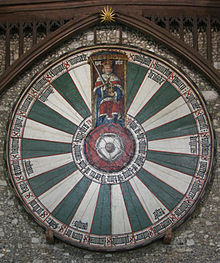Winchester (archaically known as Winton and Wintonceastre) is a historic cathedral city and former capital city of England. It is thecounty town of Hampshire, in South East England. The city lies at the heart of the wider City of Winchester, a local government district, and is located at the western end of the South Downs, along the course of the River Itchen.[2] At the time of the 2001 Census, Winchester had a population of 41,420.[1]
Winchester developed from the Roman town of Venta Belgarum. Winchester's major landmark is Winchester Cathedral, one of the largest cathedrals in Europe, with the distinction of having the longest nave and overall length of all Gothic cathedrals in Europe. The town is also home to the University of Winchester and the famous public school, Winchester College. The city's architectural and historic interest, and its fast links to other towns and cities have led Winchester to become one of the most expensive and desirable areas of the country.[3] A person who is from or resides in Winchester is sometimes locally known as a Wintonian.
Landmarks
Cathedral
Main article: Winchester Cathedral
Winchester Cathedral, the longest cathedral in Europe, was originally built in 1079. It contains much fine architecture spanning the 11th to the 16th century and is the place of interment of numerous Bishops of Winchester (such as William of Wykeham), Anglo-Saxon monarchs (such asEgbert of Wessex) and later monarchs such as King Canute and William Rufus,[12] as well as Jane Austen. It was once an important pilgrimagecentre and housed the shrine of Saint Swithun. The ancient Pilgrims' Way travelling to Canterbury begins at Winchester. The plan of the earlierOld Minster is laid out in the grass adjoining the cathedral. The New Minster (original burial place of Alfred the Great and Edward the Elder[12]) once stood beside it. It has a girls choir and a boys choir, which sing on a regular basis at the cathedral.
The Winchester Cathedral Close contains a number of historic buildings from the time when the cathedral was also a priory. Of particular note are the Deanery which dates back to the thirteenth century. It was originally the Prior's House, and was the birthplace of Arthur, Prince of Wales in 1486. Not far away is Cheyney Court, a mid fifteenth century timber framed house incorporating the Porter's Lodge for the Priory Gate. It was the Bishop's court house.
The earliest hammer-beamed building still standing in England is also situated in the Cathedral Close, next to the Dean's garden. It is known as the Pilgrims' Hall, as it was part of the hostelry used to accommodate the many pilgrims to Saint Swithun's shrine. Left-overs from the lavish banquets of the Dean would be given to the pilgrims who were welcome to spend the night in the hall. It is thought by Winchester City Council to have been built in 1308. Now part of The Pilgrims' School, the hall is used by the school for assemblies in the morning, drama lessons, plays, orchestral practices, Cathedral Waynflete rehearsals, the school's Senior Commoners' Choir rehearsals and so forth.
Castle
Winchester is well known for the Great Hall of its castle, which was built in the 12th century. The Great Hall was rebuilt, sometime between 1222 and 1235, and still exists in this form. It is famous for King Arthur's Round Table, which has hung in the hall from at least 1463. The table actually dates from the 13th century, and as such is not contemporary to Arthur. Despite this it is still of considerable historical interest and attracts many tourists. The table was originally unpainted, but was painted for King Henry VIII in 1522. The names of the legendary Knights of the Round Table are written around the edge of the table surmounted by King Arthur on his throne. Opposite the table are Prince Charles''Wedding Gates'. In the grounds of the Great Hall is a recreation of a medieval garden. Apart from the hall, only a few excavated remains of the stronghold survive amongst the modern Law Courts. The buildings were supplanted by the King's House, now incorporated into the Peninsula Barracks where there are several military museums. Winchester is also home to the Army Training Regiment Winchester, otherwise known as Sir John Moore Barracks, where Army recruits undergo their phase one training.
Education
Winchester College
The buildings of Winchester College, a public school founded by William of Wykeham, still largely date from their first erection in 1382. There are two courtyards, a gatehouse, cloister, hall, a large college chapel and it also owns "The Water Meadows" through which runs a part of the River Itchen. It was planned to educate poor boys before they moved on to New College, Oxford and often a life in the church.
Context of: wikipedia.org




No hay comentarios:
Publicar un comentario